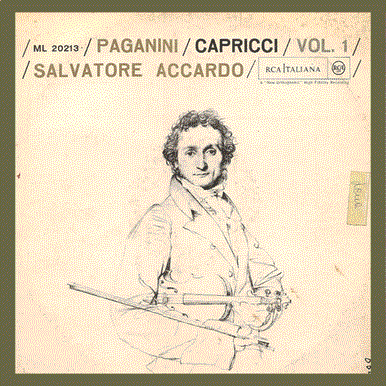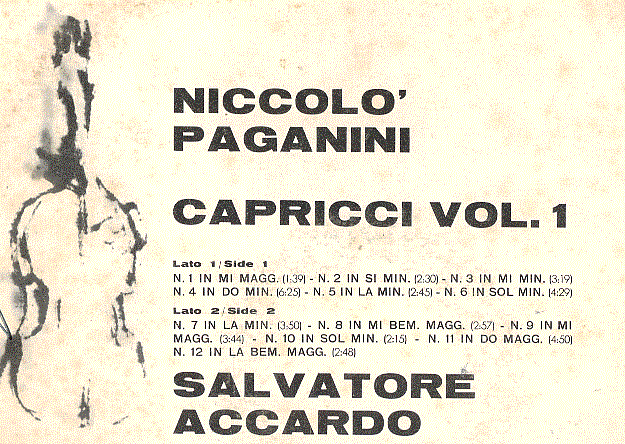|
NICCOLO PAGANINI - CAPRICCI VOL 1 - SALVATORE ACCARDO
I « 24 Capricci per violino solo furono pubblicati nel 1820; Paganini ne
aveva iniziato la composizione assai giovane, nel 1797, di ritorno dal
suo primo giro di concerti
ufficiale in molti importanti centri italiani. Ma il suo astro già
brillava di luce vivida, ed improvviso come una folgore già era apparso
a turbare con gli inquietanti aspetti
del suo genio un mondo non preparato a tanta trascendentale bravura. Il
Paganini grande esecutore e virtuoso del violino difatti era nato assai
presto, e, ciò 'che ancor più
sbalordisce, superando d'un colpo e in modo perentorio, più che
assimilando, tutte le precedenti conquiste della tecnica violinistica.
Non vi è spiegazione che possa
giustificare un simile fenomeno, se non ricorrendo forse alla bizzarria
di una natura capricciosa. Ed è questo l'aspetto che più affascinò il
pubblico del tempo, e che ancora
circonda la sua figura di un'aureola di leggenda.
I « Capricci » riflettono fedelmente tutta la musicalità di Paganini,
fatta di estro, esasperato virtuosismo, sapienza strumentale ed
estemporanea 'invenzione. Mai anzi come
per questi 24 brevi pezzi il titolo di « capriccio » trova una aderenza
precisa e calzante. Di piccole proporzioni strutturali, il « capriccio
.> sboccia da spunti improvvisi, e si
snoda attraverso un verticoso susseguirsi di artifici tecnici; ma, lungi
dal ridursi a mero esercizio didattico, l'espressione vi è concisa,
l'idea musicale scolpita e penetrante.
Il violino vi è sfruttato in tutte le risorse possibili, e con
innovazioni tecniche la cui arditezza ancor oggi, a distanza di un
secolo e mezzo, sfida il tempo. Da quanto si è detto,
è chiaro che il carattere dei « Capricci varia da pezzo a pezzo. Può
essere un fantasioso turbinio di note (cfr. n. 1 e 5) o un nobile arioso
(n. 6), un brano• in stile di « caccia »
(n. 9) o un momento di rarefazione espressiva (n. 20). lo scherzo
pungente di una sbrigliata fantasia (come il leberrimo n. 13) o un
elaborato tema con variazioni (come l'altrettanto famoso n. 24, ripreso
e svolto in seguito da musicisti quali Brahms e Liszt).
Ma in tutti la personalità prepotente di Paganini è presente con la
profonda sapienza profusa e con il suggestivo funambolismo sonoro.
I « Capricci » compendiano insomma tutte le qualità esecutive e musicali
dell'eccezionale violinista genovese. Essi in certo senso ce lo
umanizzano, ce lo rendono più familiare e comprensibile, spazzando via
tutto quel che di demoniaco la fantasia dei contemporanei ed in genere
il periodo romantico avevano morbosamente creato intorno alla sua
figura. Sotto questo aspetto, essi sono da considerarsi come la rua
opera migliore e più genuina: il vero monumento innalzato dal suo
spirito fervido ed irrequieto al proprio elevatissimo ideale artistico,
raro saggio insieme di profonda sapienza violinistica e di mirabile,
efficacissima plasticità espressiva. B. M.
Salvatore Accardo è nato a Torre del Greco (Napoli) nel 1941; iniziò lo
studio del violino a sei anni sotto la guida amorevole di un grande
Maestro della scuola Napoletana, Luigi d'Ambrosio, e consegui il diploma
presso il Conservatorio di S. Pietro a Majella nel 1956. Da questo anno
per il giovanissimo violinista cominciarono le grandi affermazioni in
Italia e all'estero: fra l'altro conseguì il primo premio assoluto al
Concorso Internazionale «Nicolò Paganini » di Genova, ove suonò il
famoso « Guarnieri del Gesù, che appartenne a Paganini. Ha compiuto già
numerose tournées in Europa, ed è frequentemente apparso in radio e TV:
le critiche ovunque si sono espresse con lui in termini entusiastici.
Recentemente ha stretto un importante contratto che lo vedrà impegnato
in una lunga tournée di concerti nel Nord-America.
The 24 Capricci » for solo Siolin were published in 1820; Paganini had
begun their composition in 1797, on returning -from his first tour of
formal concerts in many important Italian cities. But his star was
already shining with vivid light; his genius had already made its
appearance, like a sudden flash of lightning, to disturb with its
disquieting aspects a world not prepared for such transcendental
bravura. The Paganini who was a great performer and virtuoso of the
violin did, in fact, come to maturity very early; more astonishingly, he
did not merely assimilate, but mastered peremptorily and at one stroke,
all the preceding accomplishments in the field of violin technique.
There is no explanation for such a phenomenon, unless it he in the
eccentricity of a capricious nature. And it is this aspect that most
fascinated the public of his time, and that still encircles his figure
with an aureole of legend.
The « Capricci » faithfully reflect the whole character of Paganini's
musicality, a musicality made up of inspiration, exasperated virtuosity,
technical excellence and extemporaneous invention. Never has the term .<
capriccio » been so apt, so precise, as it is for these 24 brief pieces.
Of small structural proportions, the .. capriccio starts into life with
impromptu entries, unwinding itself with the vorticose prompting of
technical devices; but, far from becoming a merely didactic exercise, it
is concise in expression, and the musical idea is clear-cut and
penetrating. All the possible resources of the violin are exploited, and
with technical innovations whose boldness, even today, at the distance
of a century and a half, seems to defy time. From what has been said, it
is clear that the nature of the «capriccio» varies from one piece to
another. It may be a fantastic eddying of notes (ef. nos. 1 and 5) or a
noble ariose (n. 6), a piece in the style of the caccia (no. 9) or a
moment of expressive rarefaction (no. 20), the sharp and pungent play of
unbridled fantasy (like the celebrated no. 13) or an elaborate theme
with variations (like the equally renowned no. 24, later taken up and
developed by such musicians as Brahms and Liszt). But in all the «
Capricci » the imposing personality of Paganini is present, with its
profound, profuse brilliance and its
suggestive, resonant agility.
The .. Capricci » 'epitomize, in fact, all the qualities of execution
and musicality of the exceptional Genovese violinist. In a certain
sense, they humanize him, render him more familiar and comprehensible,
sweeping away the demoniacal quality that the imagination of his
contemporaries, and the romantic period in general, had morbidly created
around his figure. In this respect, they are to be considered as his
best and most genuine work: a true monument raised by his fervid and
restless spirit to his own extremely high artistic ideal; a rare and
masterful combination of profound knowledge of the violin and admirable,
effective expressive plasticity.
Salvatore Accardo was born at Torre del Greco (Naples), in 1941; he
began his study of the violin at the age of six, under the loving
guidance of a great maestro of the Neapolitan School, Luigi d'Ambrosio,
and obtained his diploma frani the Conservatory S. Pietro a Majella, in
1956. From that time, his achievements in Italy and abroad have been
notable: among these, his taking of the first prize in the International
Competition « Nicole) Paganini » at Genoa, where he played Paganini's
famous • Guarnieri del Gesu ». He has already completed numerous concert
tours in Europe and has frequently appeared on radio and television.
Everywhere, critics have referred to him in enthousiastic terms.
Recently, he has concluded an important contract, engaging himself for a
long North American tour.
CORPORAZIONE ARTI GRAFICHE - ROMA VIA L. MANTEAAZZA 59 - 0-62 1000
PRINTED IN ITALY RCA ITALIANA S.P.A. - ROMA • VIA TIBURTINA KM. 12 |





